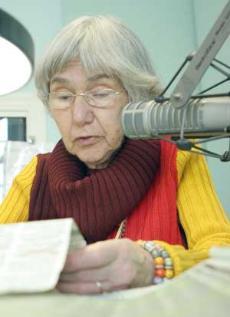Like many Raleigh residents, Les Seitz keeps up with the news. The UNC-Chapel Hill graduate enjoys the Independent Weekly and stays informed by way of the New York Times and RaleighÕs News and Observer. Seitz, 47, is blind.
A retired tax law specialist for IRS, Seitz is one of many visually impaired in North Carolina who listen to the news via the Triangle Radio Reading Service. Stationed in Raleigh, the reading service broadcasts a variety of programs in which local and national newspapers, local TV schedules and other publications are read on the air for those who cannot pick up printed material and read it.
“I like finding out the store ads,” Seitz said. “The News and Observer publishes drugstore and grocery store ads for whatÕs on sale, which allow me to do what a sighted person would do.”
The reading service is on the air 24 hours a day, seven days a week.
According to director Linda Ornt, the station produces 89 hours a week of local programming. When the station is not doing local broadcasts, the New York City reading service — InTouch Networks — is broadcast via satellite.
“With so many displaced Yankees in this area of the world, they appreciate knowing whatÕs still happening back up North,” Ornt laughed. “Plus, these are major national newspapers that give them a better grasp of whatÕs the current thinking on a variety of local and national events “
According to Ornt, the reading service is available to approximately 97,000 households in North Carolina.
“Our radio signal now comes from WUNC, and that allows us to reach 20 counties here in North Carolina,” Ornt said. “Because of our central location here in the state, we are the underlying network for the radio reading services that are active in Greenville, Rocky Mount and Wilmington.”
This growing radius of signal capacity, however, is the result of 25 years on the air. When communication professor Edward Funkhouser founded the station in 1982, the radio signal could only be transmitted to specific receivers. According to Funkhouser, these receivers were purchased with money from donations and distributed to the blind through the Sir Walter Lions Club.
The idea for the station began when FunkhouserÕs girlfriend of the time invited him to record readings of academic journals for the North Carolina Library for the Blind and Physically Handicapped.
“I thought, here we are recording the North Carolina Historical Review, which is one of the really academic journals with footnotes that are longer than the article,” Funkhouser said. “ThatÕs all well and good — IÕm not saying thatÕs bad — but blind people out there canÕt even get the daily newspaper. WouldnÕt it be cool if we had some way to get the daily newspaper out to people?”
After doing some research, Funkhouser said he discovered other states had reading services for people who, for whatever reason, could not read printed material.
With an engineering student, Funkhouser wrote a proposal for a reading service radio station in Raleigh and brought it before the North Carolina Division of Services for the Blind.
“We were hoping that they would fund this thing, give us millions of dollars and we would put this thing on the air,” Funkhouser said. “Actually, we realized that we were probably not going to get millions of dollars and proposed that we start small and pull ourselves up by our bootstraps.”
The majority of the funds for the station have been donations. From the beginning, the first donations were from individuals and corporations. Contributions such as a bag of silver worth $4,200, given by a Raleigh doctor, helped get the station going.
The majority of the funds that keep the reading service on the air are still donations from individuals and corporations, though now there are several local government agencies involved.
While some listeners do contribute, annual surveys conducted by the station show that about 60 percent of TRRS listeners have an income of about $1,000 a month, Ornt said.
Currently, the budget for the station is $146,000 a year, according to Ornt.
“That pays for the staff, for the rent, utilities, keeps our communication system running — which is of course very important to us — and also allows us to recognize some volunteers when we need to,” Ornt said.
There are only two employee positions. The reading service is kept on the air through the efforts of about 140 volunteers.
Tiffany Gladney, a sophomore in communication, has been a volunteer for slightly more than a year. She learned about the service as a student in FunkhouserÕs class.
She said volunteering at TRRS is a great opportunity to gain experience and learn how a radio station works. All volunteers are trained to do their own engineering.
An applicant must pass a sight-reading audition in order to be a volunteer. When a volunteer comes in, he or she will cut out the articles to be read during his or her specific shift, either in the morning or afternoon. Volunteers read with a partner, and each pair has a script specified to that day, whether Monday through Friday, Saturday, or Sunday. The script dictates how the reader is to sign in, sign off and when to take music breaks.
Gladney said while the volunteer work at the reading service is a good resume builder and a good opportunity, it also has personal rewards.
“I walk out of there with a new perspective on life,” Gladney said. “We can take so many things for granted, like being able to read the newspaper, or even just having a voice.”
Gladney said the reading service increases literacy.
While many visually impaired individuals, like Seitz, can read braille, the number is declining, Ornt said. The term “functionally illiterate” is a term she hates to use, but Ornt said, sadly, many of TRRS listeners have no other way to obtain printed information than through the reading service.








